Skip to comments.
Attack On Europe: Documenting Russian Equipment Losses During The 2022 Russian Invasion Of Ukraine (2 year anniversary)
ORYX ^
| Since February 24, 2022 and daily
| ORYX
Posted on 02/24/2024 5:59:01 AM PST by SpeedyInTexas
This list only includes destroyed vehicles and equipment of which photo or videographic evidence is available. Therefore, the amount of equipment destroyed is significantly higher than recorded here. Loitering munitions, drones used as unmanned bait, civilian vehicles and derelict equipment are not included in this list. All possible effort has gone into avoiding duplicate entries and discerning the status of equipment between captured or abandoned. Many of the entries listed as 'abandoned' will likely end up captured or destroyed. Similarly, some of the captured equipment might be destroyed if it can't be recovered. When a vehicle is captured and then lost in service with its new owners, it is only added as a loss of the original operator to avoid double listings. When the origin of a piece of equipment can't be established, it's not included in the list. The Soviet flag is used when the equipment in question was produced prior to 1991. This list is constantly updated as additional footage becomes available.
(Excerpt) Read more at oryxspioenkop.com ...
TOPICS: Military/Veterans
KEYWORDS: 0killthisthread; 0putinsfolly; 0putinswar; 1637borders; 3daywar; agitprop; alfredeblitz; americalast; angrykeywordtroll; anotherputinfail; anydaynow; anydaynowputinwins; anydaynowrussiawins; anydaynowukrainewins; assistantdemsonfr; attackoneurope; beaubothebsartist; beauzo; bidenswar; bobomaximus; breevingroom; byepif; byespeedy; cantbreev; cheesymaximus; crazyivan; dailydeathfap; dailypropaganda; deadthread; deathcult; deepinthespamforest; delusionalzeepers; demyanganul; dimwit; dippythemelon; dualcitizenssuck; escalation; fishiemaximus; foreigntrolls; foreigntrollsonfr; formersovietofficers; freeploader; freeploadingspammer; gabbagabbahey; ghoulishdelight; gleefulnosegold; globohomo; goodriddance; hopium; irynazarutska; itsoveriwasright; jonboy; jonboyputinlover; jonputinbot; keiththedimwit; kievstronk; liberalatpost7819; liedaboutleaving; melon; melonballsforever; melonlovesputin; melonlovesrussia; melonmemewarrior; melonmlrs; motherpif; muscovite; nato; omgputinputinputin; oyveygoyim; paidazovfans; paidazovtrolls; paidrussiantrolls; pancakemaximus; phdft; pifpouf; pifpuffs; planetzeep; polygamy; propagandareturns; put; putin; putinsfolly; putinstarted; putinswar; russia; russiandelusions; saintvolodymyr; siloviki; slaviccivilwar; slavictrolls; snufffilmsonfr; snufffilmtx; snuffpornforzeepers; snuffyfromtexas; spammyintexas; speedomaximus; speedycameback; speedyhadenough; speedyintroll; speedyisaliveandwell; speedyisdeadandfried; speedylied; stankazzintx; stankazztexicunt; staygonethistime; stenrynning; stinkstankstunkazz; stpetersburgtrolls; talkingtomypif; thisthreadisdead; tippecanoeandpiftoo; toldyouso; tothelastrussian; tothelastukrainian; ukraine; unhealthyobsession; usaidcheckbounced; usaidtrolls; vladtheimploder; warporn; wellbye; wildberry; yostanky; yurpstronk; zeepercirclejonk; zeepercreepers; zeeperdeathcult; zeeperhomeworld; zeeperloveazov; zeeperpr0n; zeepers; zeepersjustwannazeep; zeeperslovedeath; zeeperslovevindman; zeepersworshipdeath; zeepervictoryparade; zeepharder; zeeploaders; zeepyintexas; zipadeedoodah; zot; zottedintexas; zottyintexas
Navigation: use the links below to view more comments.
first previous 1-20 ... 16,201-16,220, 16,221-16,240, 16,241-16,260 ... 22,381-22,386 next last
To: JonPreston
“Putin is a legitimate military target”
That is simply a legal fact, under the Laws of War.
To: BeauBo
This isn’t a war, and calling for his assassination should have serious repercussions.
To: gleeaikin
Russian Offensive Campaign Assessment, May 26, 2025
Russian forces conducted one of their largest drone and missile strikes of the war against Ukraine on the night of May 25 to 26 after three nights of record strikes. The May 25-26 strike is now the second largest combined strike of the war, after Russian forces conducted the largest combined strike on the night of May 24 to 25. The Ukrainian Air Force reported that Russian forces launched nine Kh-101 cruise missiles from the airspace over Saratov Oblast and 355 Shahed and decoy drones from the directions of Bryansk, Kursk, and Oryol cities; Millerovo, Rostov Oblast; Shatalovo, Smolensk Oblast; Primorsko-Akhtarsk, Krasnodar Krai; and occupied Cape Chauda, Crimea.[1] The Ukrainian Air Force reported that Ukrainian forces shot down all nine Kh-101 missiles and 233 drones over northern, eastern, southern, western, and central Ukraine and that 55 drones were “lost.” Ukrainian officials reported that the Russian strikes targeted Chernihiv, Khmelnytskyi, Kharkiv, Odesa, and Kyiv oblasts.[2] Ukrainian officials stated that the strikes caused civilian casualties and damaged civilian infrastructure and private residences.

[3] Russian strikes against Ukraine continue to disproportionately impact civilians and civilian infrastructure.[4] Ukrainian President Volodymyr Zelensky stated on May 26 that Russia launched over 900 drones against Ukraine over the last three days and that intensified Russian strikes have a significant political meaning.[5] Zelensky stated that Russian President Vladimir Putin is choosing to continue the war rather than engage in meaningful peace negotiations and that there is no evidence that Russia is considering a diplomatic end to the war.[6] Russia may be increasing strikes against Ukraine as part of a cognitive warfare effort to weaken Ukrainian resolve and to undermine Western support for Ukraine.
Russia's increased missile stockpiling, drone production, and drone adaptations demonstrate Russia's commitment to achieving its war goals through military means in a protracted war in Ukraine. The Economist reported on May 25 that Ukrainian government sources estimate that the Kremlin has a stockpile of 500 ballistic missiles.[7] The Economist also reported that Russia is increasing its production of Shahed drones and can currently produce approximately 100 Shaheds a day — roughly four to five times their assessed daily production rate in late 2024.[8] Ukrainian military intelligence told the Economist that Russia plans to increase its production to 500 drones a day by an unspecified future deadline. Ukrainian drone engineers reported that Russia is actively innovating and adapting its Shahed drones to circumvent Ukrainian air defenses, including by using artificial intelligence (AI) and Ukrainian internet and mobile internet networks for navigation to prevent Ukrainian electronic warfare (EW) interference. A Ukrainian officer told the Economist that Russian drones are flying at an altitude of 2,000 to 2,500 meters, which is out of range of the small-caliber guns and shoulder-fired missiles that Ukrainian mobile air defense crews use. Ukrainian Center for Countering Disinformation Head Lieutenant Andriy Kovalenko stated on May 25 that Russian forces recently set a new Shahed flight altitude record of 4,900 meters.[9] Ukrainian Air Force Spokesperson Colonel Yurii Ihnat stated on May 26 that Russia is increasing its production of both Shahed and decoy drones and that Russian forces are flying drones at higher altitudes.[10] Ihnat reported on May 25 that Russian forces have also resumed their use of Kh-22 cruise missiles after temporarily using fewer cruise missiles in their strike packages.[11] Increasingly large Russian strike packages are consistent with reports that Russia is significantly increasing its domestic Shahed drone, decoy drone, and missile production and storage capabilities. Russia's efforts to increase domestic drone and missile production and ongoing adaptations of these strike packages are likely part of a broader Russian effort to prepare for a protracted war in Ukraine and possibly a future war with NATO.[12]
Ukrainian intelligence continues to assess that the Kremlin is committed to its war aim of achieving complete Ukrainian capitulation and is preparing for a potential future conflict with NATO — in line with ISW’s assessments. Ukraine's Foreign Intelligence Service (SZRU) Head Oleh Ivashchenko stated in an interview with Ukrainian outlet Ukrinform published on May 26 that Russia's strategic plans to gain full control over Ukraine remain unchanged.[13] Ivashchenko stated that the entire Ukrainian intelligence community agrees that Russia is trying to take control over all of Luhansk, Donetsk, Zaporizhia, and Kherson oblasts. Ivashchenko stated that Russia also has a long-term goal to establish influence over all post-Soviet states and that Russia will need two to four years after the end of hostilities in Ukraine to restore the Russian military's combat capabilities. Ivashchenko noted that Russia's ability to rearm its military after the end of its war in Ukraine will depend on Western sanctions. ISW continues to assess that Russia remains committed to pursuing demands that amount to nothing short of Ukraine's full surrender and that Russia will continue to pursue this objective so long as Putin believes Russia can militarily defeat Ukraine.[14] ISW also continues to assess that the Russian government and military are preparing for a possible future conflict with NATO.[15] Russian authorities recently renewed their years-long narrative rejecting the legality of the dissolution of the Soviet Union in 1991, likely to set conditions for Russia to deny the independence and sovereignty of other former Soviet states in the future.[16]
Ukrainian intelligence also assessed that Russia is facing a number of critical constraints in its economy and on the battlefield — in line with ISW’s ongoing assessments. Ivashchenko stated that Russia's sovereign wealth fund has fallen from its pre-war level of about $150 billion to about $38 billion and that Russia's gold and foreign currency reserves are also decreasing.[17] Ivashchenko noted that Russia is suffering from serious labor shortages, which are causing problems in the Russian economy, and that Russian authorities are trying to avoid paying the financial incentives that Russia is offering new military recruits. Ivashchenko stated that roughly 80 percent of the equipment that Russian forces are using is refurbished from Russia's Soviet-era stockpiles and that only about 20 percent of the equipment is modern. Ivashchenko's statements are in line with ISW’s ongoing assessment that Russia will face a number of materiel, manpower, and economic issues in the near to medium-term if Ukrainian forces continue to inflict damage on Russian forces on the battlefield at the current rate.[18] Russia's defense industrial base (DIB) will struggle to sustain Russia's current equipment and ammunition burn rates in the future, and Putin has mismanaged Russia's economy, which is suffering from increased and unsustainable war spending, growing inflation, significant labor shortages, and reductions in Russia's sovereign wealth fund.
Russia's own defense industrial production limitations are pushing Russia to rely on its allies and partners and to find cheap solutions to adapt to Ukraine's drone and counter-drone capabilities. Ivashchenko highlighted North Korea's contribution of six million artillery shells, 120 M1989 Koksan self-propelled artillery systems, and 120 M1991 multiple launch rocket systems (MLRS) to Russia since the start of Russia's full-scale invasion.[19] Ivashchenko stated that the People's Republic of China (PRC) is supplying machines, chemicals, gunpowder, components, and aviation equipment to at least 20 Russian defense industrial enterprises and that 80 percent of the critical electronics in Russian drones are Chinese made. Ivashchenko stated that Belarus is producing ammunition for Russia and that the Belarusian and Russian DIBs are largely integrated. Russian forces have increasingly supplied frontline units with motorcycles and Chinese- and Russian-made buggies for use in assaults — a response to Ukrainian drone advantages on the battlefield and an effort to offset significant armored vehicle losses.[20] Russia's recent extensive modifications to its long-range Shahed and decoy drones demonstrate that Russia is trying to adapt to Ukraine's successful countermeasures that have been effectively repelling Russia's drone strikes.[21] Russian forces had previously used Shahed drones to overwhelm Ukrainian air defenses so as to allow Russian missiles to hit their targets, but Russia's recent modifications to the drones suggest that Russia is attempting to restore the Shahed as an effective weapon itself.[22] Russia is likely focusing on adapting the Shaheds, increasing their production rate, and launching them in increasingly large quantities as the drones are relatively cheap and can be mass produced — unlike costly missiles that Russia can only produce at a relatively much lower rate. Russia is learning lessons about how to adapt its drone and missile strike packages to most effectively penetrate a large air defense umbrella and deplete air defense missile stockpiles, and Russia will carry these lessons into any future conflict.
Russian President Vladimir Putin's recent demand for Russian forces to create a “buffer zone” along the Russia-Ukraine international border, in addition to Russia's ongoing efforts to seize the remainder of Luhansk, Donetsk, Zaporizhia, and Kherson oblasts, ignores Russia's constraints and underscores Putin's intention to increase his territorial demands. Ukrainian military observer Kostyantyn Mashovets reported on May 26 that the Russian military command recently redeployed elements of the 752nd Motorized Rifle Regiment (3rd Motorized Rifle Division, 20th Combined Arms Army [CAA], Moscow Military District [MMD]) and 200th Motorized Rifle Brigade (14th Army Corps [AC], Leningrad Military District [LMD]) to reinforce the Russian force grouping attacking into northern Sumy Oblast.[23] Mashovets stated that elements of the 200th Motorized Rifle Brigade are operating near Volodymyrivka (north of Sumy City) and in Gordeevka (just north of Volodymyrivka in Russia). Elements of the Russian 752nd Motorized Rifle Regiment have been operating in the Borova and Lyman directions since at least mid-2024.[24] ISW has observed elements of the 200th Motorized Rifle Brigade engaged in combat in the Bakhmut-Chasiv Yar direction — a priority direction for the Russian military — since mid-2023 and observed reports of the brigade operating in Chasiv Yar as recently as May 6.[25] ISW has not observed additional reports of these units operating in northern Sumy Oblast but will cover any future reports about these units.
ISW previously noted that Russian forces’ inability to penetrate Ukrainian defenses west and southwest of Chasiv Yar is undermining Russia's ability to prepare for major offensive operations against Kostyantynivka and the wider Ukrainian fortress belt.[26] Redeploying forces away from Chasiv Yar suggests that the Russian military command may intend to delay its offensive operation against Kostyantynivka and supports ISW’s ongoing assessment that Russia does not currently have sufficient operational reserves to intensify offensive operations in several different directions simultaneously.[27] The Russian military command's decision to redeploy units away from this effort suggests that the Russian military may try to simultaneously continue advances in Donetsk Oblast and establish a buffer zone in northern Chernihiv, Sumy, and Kharkiv oblasts, however. The Russian military command may assess that Russian forces have a greater chance of significant advances in northern Sumy Oblast than near Chasiv Yar. Putin recently orchestrated a meeting with Russian officials to float the idea of creating an at least 25-kilometer-wide buffer zone in northern Sumy Oblast, and Putin ordered Russian forces to establish a buffer zone in northern Kharkiv Oblast in May 2024.[28] ISW previously assessed that Putin likely intends to leverage buffer zones in northern Sumy and Kharkiv oblasts to justify expanding his claims over Ukrainian territory beyond Russia's long-standing claims over Luhansk, Donetsk, Zaporizhia, and Kherson oblasts.[29]
https://www.understandingwar.org/backgrounder/russian-offensive-campaign-assessment-may-26-2025
16,223
posted on
05/26/2025 9:42:32 PM PDT
by
AdmSmith
(GCTGATATGTCTATGATTACTCAT)
To: BeauBo; blitz128
Russian Railways has run out of money to purchase rails, wagons and locomotives Russian Railways’ investment program, which initially amounted to 1.3 trillion rubles and was then cut to 890 billion rubles, will be reduced by another 32.5 billion rubles. Russian Railways plans to cut expenses on the renewal and modernization of fixed assets, including railway tracks, as well as locomotives and cars, Reuters cites the company's presentation.
Due to the decline in freight traffic, which fell to a 15-year low last year and fell by another 6.8% in January-April of this year, Russian Railways will lose 87 billion rubles: according to the new plan, the state corporation's annual revenue will amount to 2.711 trillion rubles instead of 2.8 trillion. The volume of freight traffic on the Russian Railways network in 2025 will decrease by 36.7 million tons, to 1.205 billion tons, which is 3% less than planned, according to the presentation. A sharp increase in interest rates on loans has become a headache for Russian Railways, a source close to the monopoly told Kommersant earlier. Russian Railways budgeted the Central Bank rate at 16% per annum, while in reality it reached 21%. As a result, this year, Russian Railways will have to spend almost a quarter of its revenue, or 688 billion rubles, on loan payments alone, which is almost 6 times higher than the 2023 figure.
Last year, the company received 162 billion rubles in budgetary infusions. But whether the government will be able to help Russian Railways again remains a question: the treasury desperately needs money to pay for the war with Ukraine, which has already cost 20 trillion rubles and will require another 13 trillion in 2025. In order to make ends meet in the budget, Russian Railways had previously sharply reduced spending on infrastructure construction: the project to expand the BAM and the Trans-Siberian Railway, which is critically needed to export raw materials to China, lost two-thirds of its funding: instead of 375 billion rubles, it will be 117 billion. At the same time, it was decided to essentially freeze spending on developing approaches to ports in the European part of the Russian Federation.
https://www.moscowtimes.ru/2025/05/26/urzhd-zakonchilis-dengi-nazakupki-relsov-vagonov-ilokomotivov-a164354
16,224
posted on
05/26/2025 10:04:05 PM PDT
by
AdmSmith
(GCTGATATGTCTATGATTACTCAT)
To: gleeaikin; PIF
The Muscovy National Guard is being modernized 26MAY2025 For the first time, the Russian National Guard will be issued socks instead of foot wraps
Instead of foot wraps, servicemen will now receive socks. This is stated in a draft order posted on the federal portal of draft regulatory legal acts. According to the text of the document, the changes are being made in order to “preserve the health of citizens undergoing military training in the National Guard troops, as well as to exclude foot wraps from the supply standards as an obsolete item of clothing.”
Foot wraps — rectangular pieces of fabric for wrapping the legs — have been an indispensable element of Russian soldiers’ uniforms for centuries. The Russian Defense Ministry, which does not control the Russian National Guard, completely abandoned foot wraps 11 years ago — on the initiative of then-Defense Minister Sergei Shoigu.
https://www.moscowtimes.ru/2025/05/26/rosgvardii-vpervie-nachnut-vidavat-noski-vmesto-portyanok-a164339

16JAN2013
Why Russian soldiers are finally replacing foot wraps with socks
They have been standard issue since the days of Peter the Great. But, finally, portyanki have reached the end of the road. Portyanki, the squares of cloth (cotton for summer, flannel for winter) in which Russian soldiers have wrapped their feet since the days of Peter the Great, have lost their last and greatest battle – against socks.
“The most crucial aspect is that one can only wear portyanki that are wrapped tightly,” Dimitriev says. “If the soldier doesn't follow the procedure exactly, he could hurt his feet and get painful blisters.” You also had to be able to put your portyanki on fast: Red Army regulations stipulated soldiers had to be fully dressed within 45 seconds. The rags, which inevitably got pretty rancid, were changed weekly, at the same time as the soldier's shower, and then boiled at 100C.
https://www.theguardian.com/world/shortcuts/2013/jan/16/russian-soldiers-replacing-foot-wraps-socks
First 3 min: Jackboots and Footwraps | Soviet Army Footwear
https://www.youtube.com/watch?v=P8pfCFquEs8
16,225
posted on
05/26/2025 10:32:37 PM PDT
by
AdmSmith
(GCTGATATGTCTATGATTACTCAT)
To: blitz128; BeauBo
Day 1,188 of the Muscovian invasion. 990 [average is 827/day], i.e. more than 41 Russians and Norks/h. Vehicles and fuel tanks more than 50% above average. Motorcycles are not counted yet.
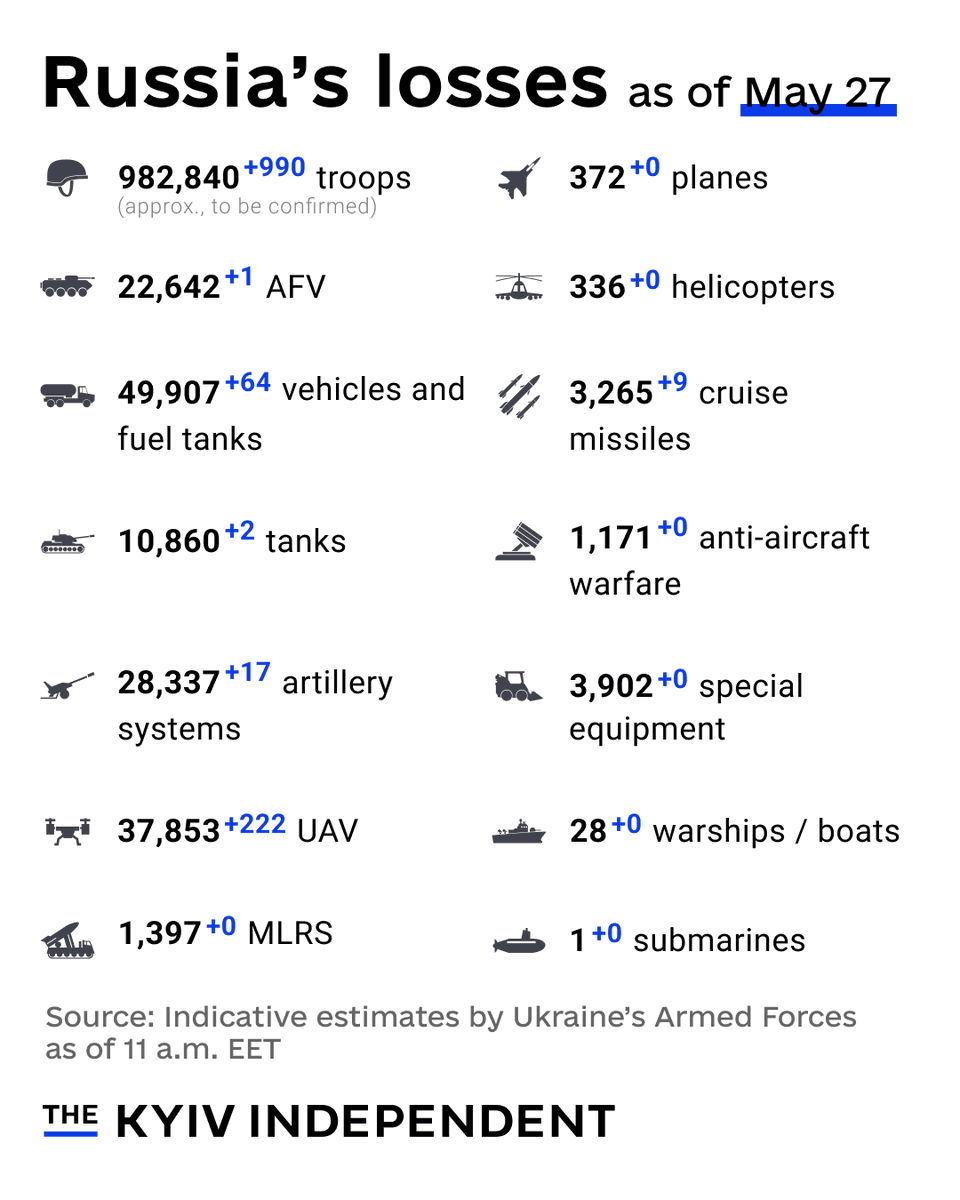
16,226
posted on
05/27/2025 12:11:04 AM PDT
by
AdmSmith
(GCTGATATGTCTATGATTACTCAT)
To: BeauBo
lol just a “policing action”😎
To: AdmSmith
Lots of Russian GDP being blown up, imagine all those in the eastern nether regions appreciate how that is improving their lives😎
To: BeauBo; PIF; Dopey
From Elon's Grok 3. This isn't a war, nor is Putin subject to the childish theory of assassination that you put forward.
Grok 3
Russia has not officially declared war on Ukraine in the legal sense, as it has consistently referred to its military actions as a "special military operation" (SMO) since the invasion began on February 24, 2022. The Kremlin has avoided using the term "war" to describe the conflict, with Russian officials, including President Vladimir Putin, framing it as a limited operation aimed at specific objectives like "denazification" and "demilitarization." Russian law distinguishes between an SMO and a formal declaration of war, the latter requiring specific legal steps and broader mobilization, which has not occurred. Posts on X reflect this, with some users noting Russia’s avoidance of an official war declaration even amid escalated attacks.
To: JonPreston
May 26, 2025
A Week Long Drone Fight Which Russia Is Winning
Over the last seven days the Ukrainian military has launched over one thousand drones against targets in Russia. Most of these were shot down by Russian air defenses. There are no reports of any serious damage.
The biggest effect the week long drone attacks achieved was to shut down air traffic in Moscow for several hours.
After waiting a few days the Russian military responded in kind.
Over the last three days a record number of drones and missiles were launched against military installations and production facilities in Ukraine (archived):
Russia stepped up missile-and-drone assaults on the Ukrainian capital of Kyiv and other regions, killing at least 12 people overnight into Sunday after President Trump last week declined to impose further sanctions on Moscow over its refusal to halt its invasion. Russia attacked with a total of 367 drones and missiles—one of the largest single-night raids of the war, according to the Ukrainian Air Force—in a second consecutive day of pounding strikes that sent civilians running for shelters in the middle of the night.
Over three days the Russian forces used some 1,000 heavy drones plus 58 cruise- and 31 ballistic-missiles to attack Ukraine.
The Russian attacks are overwhelming (archived) the western provided air defenses:
To: FtrPilot; BroJoeK
May 23: 2:20PM - 2 Iskander-Ms impact the Odesa Port. 4:00PM - 1 Kh-59 impacts the vicinity of Chuhuiv, Kharkiv Oblast. 4:10PM - 1 Kh-59 impacts the vicinity of Chuhuiv, Kharkiv Oblast. 8:34PM - 1 Iskander-M impacts Odesa city. 9:15PM - 1 Iskander-M impacts southeast of Pavlohrad, Dnipropetrovsk Oblast. 9:37PM - 1 Iskander-M impacts the vicinity of Pavlohrad. 10:57PM - 1 Iskander-M impacts the vicinity of Zaporizhzhia City. 11:11PM - 1 Kh-31P impacts the vicinity of Mykolaivka, Sumy Oblast. May 24:
12:58AM - 3 Iskander-Ms impact the Antonov plant in Kyiv.
1:01AM - 1 Iskander-M impacts Kyiv.
1:02AM - 1 Iskander-M impacts Kyiv.
11:48PM - 1 Iskander-M impacts the vicinity of Terny, Sumy Oblast.
11:51PM - 1 Iskander-M impacts the vicinity of Kyiv.
11:52PM - 1 Iskander-M impacts the vicinity of Kyiv.
May 25:
2:00AM - 2 Kh-69s impact west of Konotop, Sumy Oblast.
2:06AM - 1 Kh-69 impacts northeast of Nizhyn, Chernihiv Oblast.
2:31AM - 2 Kh-69s impact Konotop, Sumy Oblast.
2:37AM - 4 Kalibr impacts in Ternopil City.
2:46AM - 1 Kh-69 impact near Kotleve, Poltava Oblast.
3:06AM - ~2 Kalibr impacts on the outskirts of Kyiv.
3:07AM - 1 Iskander-M impacts Konotop, Sumy Oblast.
3:15AM - 1 Iskander-M impact in Pavlohrad, Dnipropetrovsk Oblast.
3:16AM - 1 Iskander-M impact near Pavlohrad.
3:18AM - 1 Iskander-M impact near Pavlohrad.
3:22AM - 1 Iskander-M impact in Konotop.
3:27AM - 2 Iskander-M impacts near Chernihiv City.
3:28AM - 4 Kalibr impacts in Starokostyantyniv, Khmelnytskyi Oblast.
3:31AM - 1 Iskander-M impact near Chernihiv City.
3:32AM - 1 Iskander-M impact in Konotop.
3:33AM - 3 Kh-101 impacts near Kyiv.
3:35AM - ~2 Kh-101 impacts near Kyiv.
4:03AM - 1 Iskander-M impact in Konotop.
5:02AM - 1 Kh-22 impact in Konotop.
7:40PM - 1 Kh-31P impact near Hlukhiv, Sumy Oblast.
May 26:
4:05AM - 1 Kh-59 impact near Bilyi Kolodyaz, Kharkiv Oblast.
4:30AM - 3 Kh-101 impacts at the Starokostyantyniv Airbase, Khmelnytskyi Oblast.
4:35AM - 2 Kh-101 impacts at the Starokostyantyniv Airbase.
Here are the estimated total missiles launched (including interceptions):
31 Iskander-M ballistic missiles.
24 Kalibr cruise missiles
20 Kh-101 cruise missiles.
11 Kh-59/69 cruise missiles.
1 Kh-31P anti-radar missile.
1 Kh-22 cruise missile.
Total:
58 Cruise missiles.
31 Ballistic missiles.
89 missiles in total.
(And of course, there were over 500 Geran-2 drones launched during this period).
For the map:
Orange icons are ballistic missile impacts; yellow icons are cruise missile impacts.
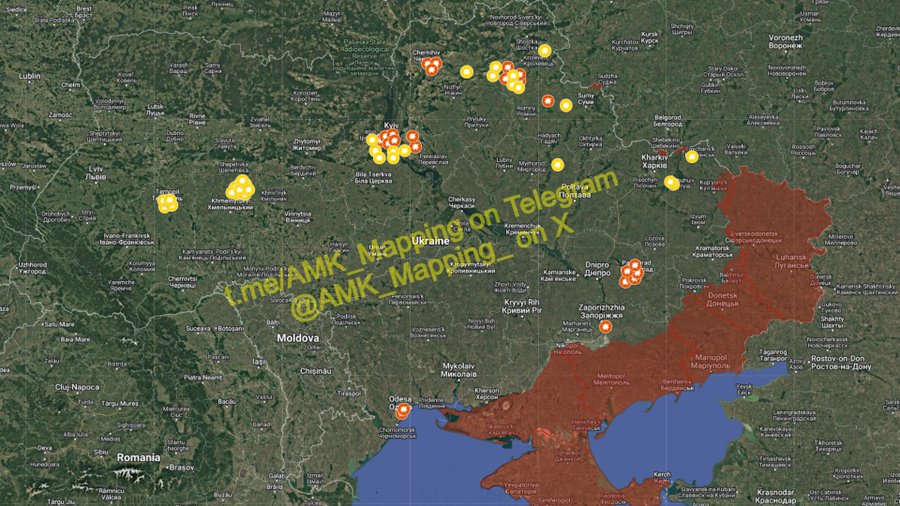
To: blitz128
OT Reminder
Starship Flight 9 will go off around 6:30 PM CST tonight.
Starship Flight 9 Prepares for Launch | What You Need To Know - NASA Spaceflight
https://www.youtube.com/watch?v=gD2Qa0Dwjyg
Starship Flight 9 Countdown to Launch
NASA Spaceflight will answer all of your questions about the upcoming Starship Flight 9, which will include the Block 2 Booster, Booster 14-2, and the Block 2 Starship, Ship 35.
https://www.youtube.com/watch?v=SsiRiWjSn4A
16,233
posted on
05/27/2025 5:07:19 AM PDT
by
PIF
(They came for me and mine ... now its your turn)
To: AdmSmith
Reporting From Ukraine:
https://www.youtube.com/@RFU/videos
The complete transcript.
—
[ Europe Sends Entire Artillery Arsenal + Tanks, AFVs, Jets, and Air Defense! ]
Today [ May 26 ], the biggest updates come from Ukraine. Here, Europe has stepped up after Russians outright refused to make any deal on a ceasefire with Ukraine. After countless warnings, Europe is now rapidly arming Ukraine to the teeth, leaving Ukrainian armed forces better prepared for the now inevitable Russian summer offensive.
Recently, the Russian Minister of Foreign Affairs, Sergey Lavrov, outright refused a ceasefire with Ukraine during a press conference with Russian media. He stated that they had tried to implement a ceasefire before, but failed and will never do it again under any circumstances other than effective capitulation.
Notably, according to President Zelensky and the Organization for Security and Co-operation in Europe of which Russia is a member, Russia and Russian-backed separatists have violated all of the various 25 ceasefires signed since 2014.
Earlier, the European Union stated that if Russia were to refuse any form of a ceasefire or serious efforts to make peace, it would implement a massive sanctions package targeting Russian economic and military assets.
The package includes additional sanctions against 189 new Russian shadow oil fleet vessels, bringing the total number of sanctioned vessels to 342. The 17th EU sanctions package also includes 31 new companies providing direct or indirect support to Russia’s military industry, such as those producing crucial technologies and chips needed for Russian missiles and other weapon systems.
More than just sanctions, European countries have significantly stepped up their game, investing large amounts into their own and Ukraine’s military industries. Ukraine has received over one billion Euros from the EU, made from profits generated from frozen Russian assets, helping to support Ukraine’s economy and wartime industry, as it continues to defend itself over 3 years into the full-scale Russian invasion.
With artillery playing a significant role in offensive and defensive operations, the UK has officially transferred their entire stockpile AS-90 self-propelled howitzers to Ukraine. Additionally, French President Emanuel Macron has confirmed that all French Caesar self-propelled howitzers produced this year will also be sent to Ukraine, translating to more than 200 French and British self-propelled guns in 2025 alone.
Additionally, the French foreign minister added that all profits generated from frozen Russian assets, seized by France, will be used to produce spare parts and equipment for the Caesar guns sent to Ukraine. This will ensure that Ukraine can continue to operate them, even through high fire rates.
Lastly, over 2/3rds of the EU’s promised 2,000,000 artillery shells have already been gathered in the first 6 months of the year. Europe and the countries it sources these munitions from are outproducing even the previously set goals, indicating a positive trend for additional deliveries in the future. Regardless, the current deliveries of shells, high-tech artillery guns, and spare parts will ensure that Ukraine can maintain an extraordinarily high fire rate, as it prepares to defend against the inevitable Russian summer offensive.
To combat Russian air strike capabilities, Ukraine is set to receive all 6 promised Norwegian F-16 fighter jets by the end of 2025, and Belgium donating 2 F-16s to use as spare parts. Additionally, footage captured of a German train convoy shows at least 10 more Gepard self-propelled air defense systems en route to the Ukrainian border.
As Germany has halted public disclosures of its military aid deliveries to Ukraine, the real number is likely much higher. These weapon systems will be able to combat Russian drone and missile strikes from the air and from the ground, continuously increasing Ukraine’s defensive capabilities, as Russia aims to do the same with its number of strikes.
Overall, with Russia openly rejecting any ceasefire and continuing its offensive plans, Europe has responded with unprecedented unity and urgency, arming Ukraine at an increasing rate. Massive sanctions have been unleashed on Russia’s shadow oil fleet and military industry, while billions from frozen Russian assets are now flowing directly into Ukraine’s defense and wartime economy.
Key European allies are transferring entire arsenals of self-propelled artillery, spare parts, and ammunition, ensuring Ukraine can sustain high fire rates, and repel the inevitable Russian summer offensive. With further F-16 and Gepard deliveries underway, European production lines are increasingly geared toward Ukraine’s survival. The message is clear, if Russia won’t stop this war, Europe will make sure Ukraine can win it.
https://www.youtube.com/watch?v=oHJYd2d8oxI
16,234
posted on
05/27/2025 5:24:17 AM PDT
by
PIF
(They came for me and mine ... now its your turn)
To: PIF; BeauBo
To: JonPreston
The corporate media of the North Atlantic are silent on the assassination attempt on the life of Putin.
What was quite astonishing, president Trump was informed by an inquisitive reporter during a press briefing … who informs the president of a near miss risk of a nuclear strike on Kyiv? Very, very telling … heads should roll.
'WHAT THE HELL': Trump rips Putin for latest attacks on Ukraine | Fox News |
Journalist briefing president Trump on world affairs ... @ 4:40
TRUMP: [...] shooting rockets into cities, killing people. I don't like what Putin is doing, not even a little bit. Q. A Russian commander said president Putin was almost caught in the middle of a drone attack from Ukraine. ...
TRUMP: I haven't heard that ... but ehh .. that may be a reason ... but I haven't heard that.
As always, politicians do not have the finger on the trigger, but the coalition of some Nine Eyes intelligence agencies including the Mossad.
Posted by: Oui | May 26 2025 14:19 utc | 8
To: LowIQ
🍈
"So I stand by the idea that pitin rejects that the Soviet union was actually desolved."
We need a complete shutdown of blitz128 until we figure out what the hell is going on.
January 7, 2023
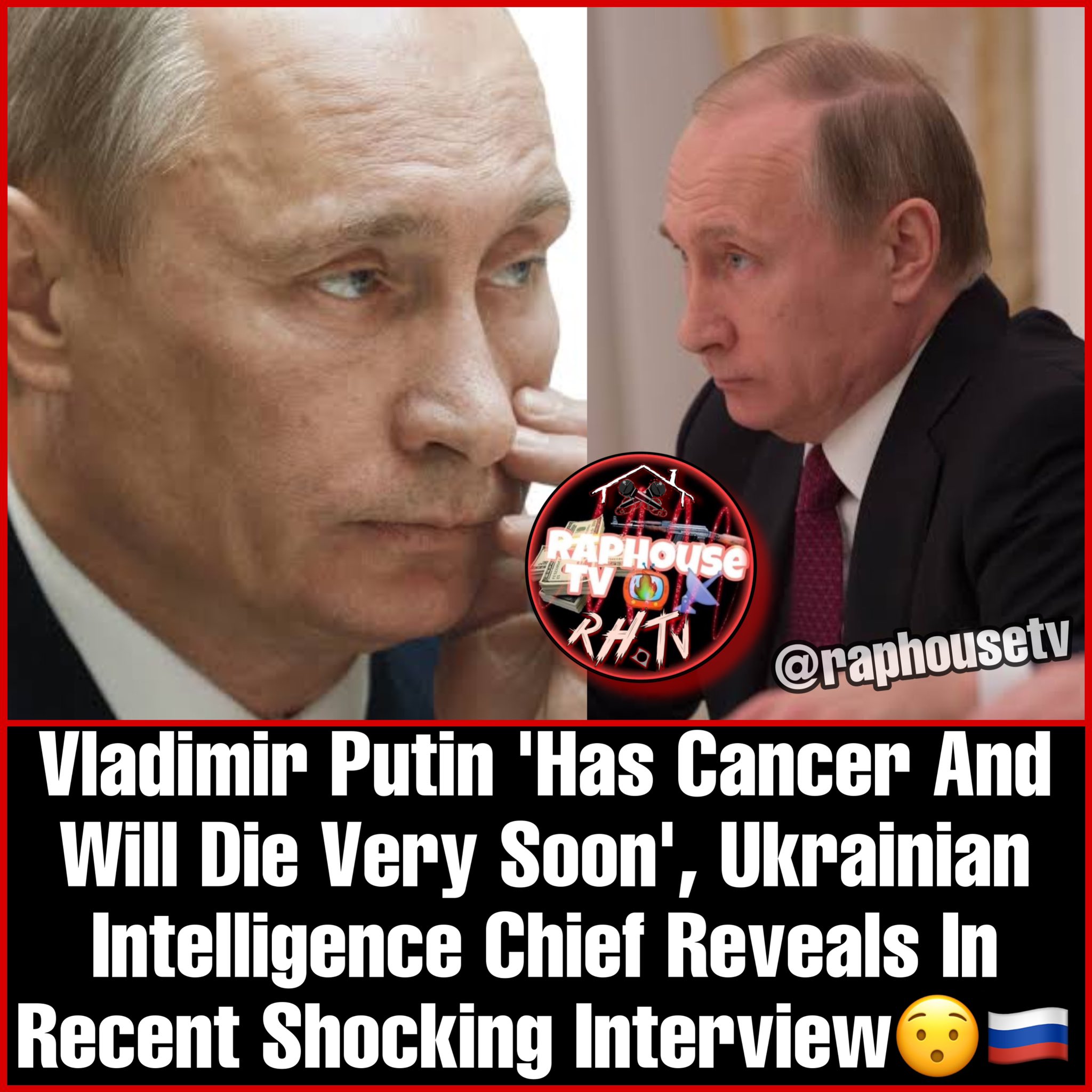
To: AdmSmith
Stop this War
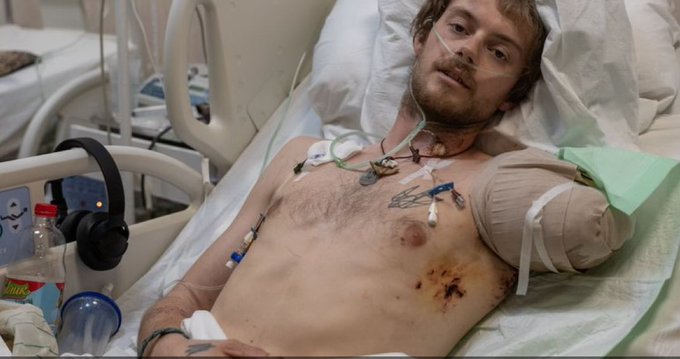
To: JonPreston
The Kremlin has avoided using the term “war” to describe the war, and therefore Jon Preston does so slavishly, in the face of the obvious war taking place.
Navigation: use the links below to view more comments.
first previous 1-20 ... 16,201-16,220, 16,221-16,240, 16,241-16,260 ... 22,381-22,386 next last
Disclaimer:
Opinions posted on Free Republic are those of the individual
posters and do not necessarily represent the opinion of Free Republic or its
management. All materials posted herein are protected by copyright law and the
exemption for fair use of copyrighted works.
FreeRepublic.com is powered by software copyright 2000-2008 John Robinson





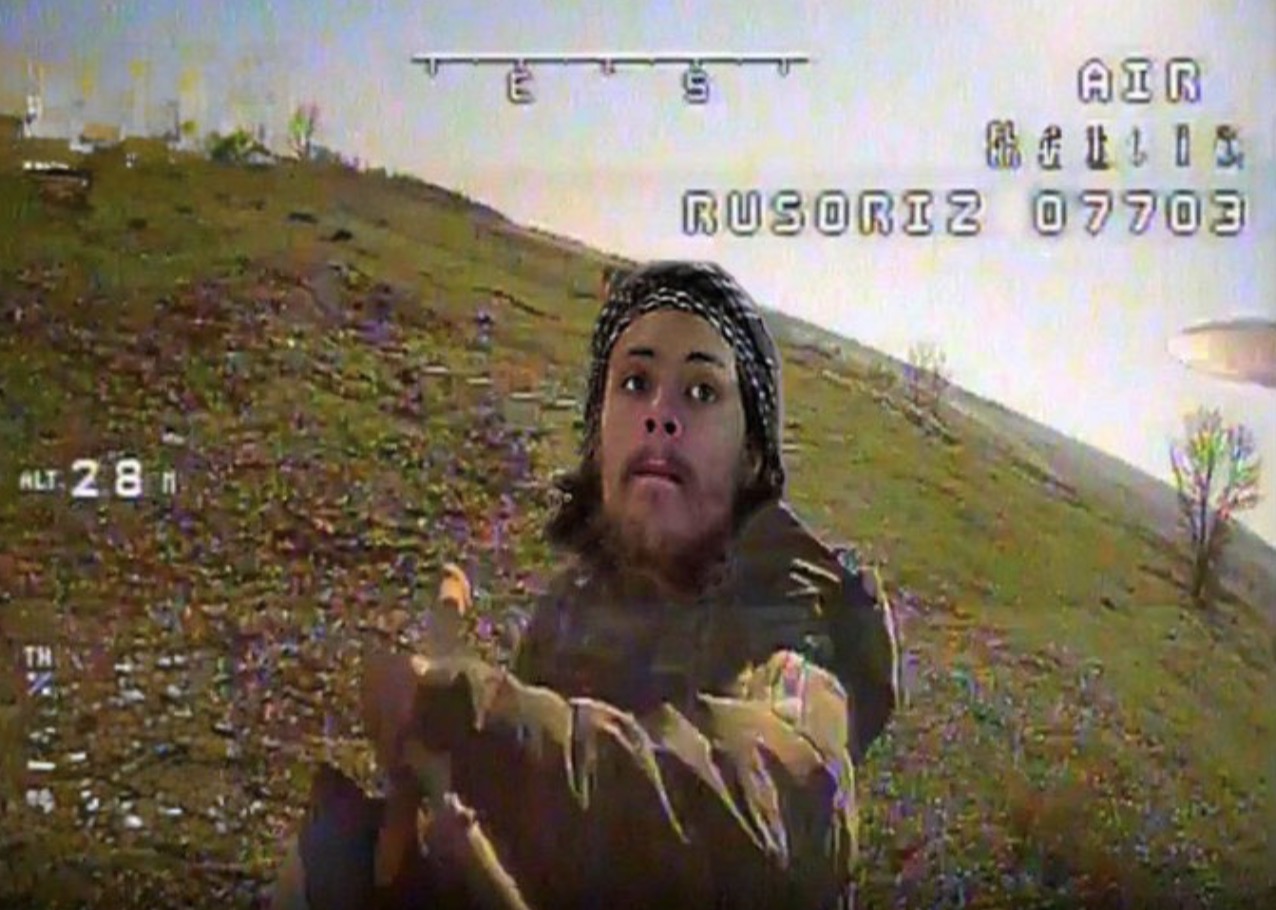
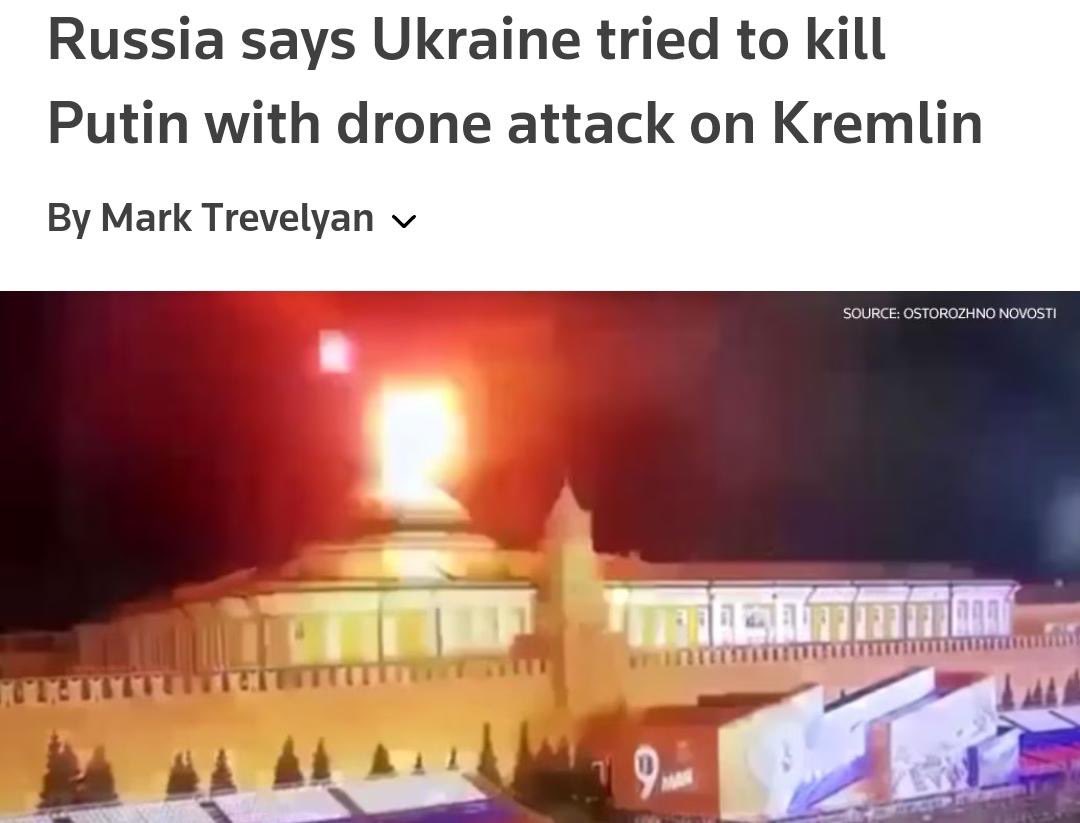


The corporate media of the North Atlantic are silent on the assassination attempt on the life of Putin.
What was quite astonishing, president Trump was informed by an inquisitive reporter during a press briefing … who informs the president of a near miss risk of a nuclear strike on Kyiv? Very, very telling … heads should roll.
'WHAT THE HELL': Trump rips Putin for latest attacks on Ukraine | Fox News |
Journalist briefing president Trump on world affairs ... @ 4:40
As always, politicians do not have the finger on the trigger, but the coalition of some Nine Eyes intelligence agencies including the Mossad.
Posted by: Oui | May 26 2025 14:19 utc | 8